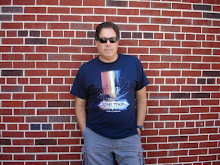
(April 1950, U.S.)
Traditionally, film noir often employs stereotypical elements such as shadows, dark and seedy alleyways and vicious femme fatales. D.O.A. might, at first glance, fool you on that level because their are many physical elements such as outdoor brightness, hotel parties and a hot, swinging jazz club to break those stereotypes. On the other hand, their is also much "tin-pan-alley" dialogue and semi-bad acting that can easily define classic film noir. What ultimately makes D.O.A. a great film is the frantically-paced plot revolving around a doomed man's quest to find out who has poisoned him – and why – before he dies. Once you wrap your head around that concept, the intruigue is hard to resist.
Frank Bigelow (played by Edmond O'Brien) is dead at the beginning of the movie from having been poisoned by a luminous toxin for which there is no antidote. Right now, he's still breathing, as he walks into a police station to report his own murder. Through a flashback, we discover how his mundane profession as an accountant and notary public inadvertently caused his own death when he innocently notarized a document for a bill of sale for what turns out to be stolen iridium. He then enters a world of criminals and psychotic hit men as he struggles to stay alive just long enough to learn the truth about his own murder. As I mentioned before, the intruige is strong, especially when you come to understand how a man's simple daily profession could ultimately get him killed.
There is a very interesting sequence that takes place at a San Francisco jazz club (where the poisoning of Frank's drink actually takes place). This scene includes one of the earliest depictions of the Beat subculture, clearly showcasing a real popular African-American jazz band of the time. Study the close-ups of the band as they play with all of their heart and souls, tearing up the night with swinging music. I should also point out that director Rudolph Maté liberally uses Broadway and the Bradbury Building in Los Angeles during his location shooting and includes the Million Dollar Theater's blazing marquee in the background. This movie theater would later serve the same function when Ridley Scott filmed BLADE RUNNER (1982) at the famous Bradbury Building.
Back in 1988, when I was in college, I saw a film with Dennis Quaid and Meg Ryan called D.O.A. When it was over, I told my friends that I thought it was the best and most original thriller I'd ever seen (up until then, anyway). Little did I know at the time it was actually a remake.
Favorite line or dialogue:
Frank Bigelow: "I wanna report a murder."
Police Captain: "Sit down. Where was this murder committed?"
Frank: "San Francisco. Last night."
Captain: "Who was murdered?"
Frank: "I was."


No comments:
Post a Comment